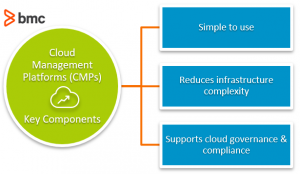The cloud has changed business as we know it, and has proliferated almost all organizational structures across every industry. With this popularity have come the options: from infrastructure, platform, and software as a service platforms, all the way to storage, security, and database services.
While organizations have more choices than ever for cloud computing, this only make things more challenging—there is no standard way to oversee it all. In fact, some businesses that once had 3,000 services under one management umbrella now have more than 10,000!
This is where having solid, scalable cloud management becomes so important.
How to manage the cloud
It is crucial that companies integrate management that can both deploy and orchestrate cloud services across the multi-vendor landscape. Management of the cloud involves everything from organizing and steering corporate resources, to ensuring full compliance is being followed and all data within the cloud is secure.
The best way to do this is through the use of cloud management tools.
(Compare cloud management to governance.)
What are cloud management tools?
Cloud management tools are those that enable organizations to manage their multi-cloud (both public clouds and those on-premise) resources and services. These tools can be purchased and operated by:
- One central organization
- Numerous lines of business
Tools can also be deployed as a SaaS product or on-premises. These tools serve nearly limitless functions and cover a variety of categories such as:
- Resource and capacity management
- Security
- Compliance
- Big data analytics

Features of cloud management tools
There are many factors to consider when trying to decide how to choose the right cloud management tools, including:
- Resource management
- Performance monitoring
- Scalability
- Automation and provisioning
- Cross-platform interoperability
- Compliance and governance
- Reporting
Let’s take a look at each.
Resource management
When it comes to cloud management tools, resource management is one of the most core functions to be included. This ability enables IT to control each resource. Along with this, service blueprints capture configuration and best practice information in order to:
- Reduce cloud administrative overhead
- Accelerate deployments
All cloud components in a production system are also tracked in the configuration management database (CMDB). Without these IT processes, managing and resolving issues around production systems is nearly impossible, not to mention inefficient and cost destructive.
Performance monitoring
Along with managing resources, the tool needs to monitor resource usage and its impact on system performance. Monitoring should be user-friendly with:
- Dashboards for quick status review
- The ability to trigger auto-scaling of resources up or down according to predefined service requirements
In addition, the monitoring tool should provide a historical context and predictions about future capacity usage so that a plan for growth can be put in place. Finally, monitoring should extend beyond the typical data center resources to include mobile and container technologies.
Scalability
Perhaps this goes without saying, but the cloud management solution needs to be able to scale. Most hybrid clouds continue to change and grow, so a management tool must be flexible to:
- Incorporate new technologies
- Scale across different geographies
Automation & provisioning
In today’s cloud world of massive scale, many could argue that the less that humans need to intervene with certain management aspects, the better.
For a wide range of operational tasks, automation is key. With the surge in artificial intelligence and AIOps tools, types of manual duties like automatically scaling up or down based on system load can take a huge load off both developers and administrators.
Given that digital innovation initiatives usually focus on delivering more frequent releases of apps to web and mobile platforms, pressure is placed on IT to support agile app development and deployment processes across the full lifecycle.
Developers and testers need fast, self-service access to cloud resources that provide consistent automated provisioning of development, test, and production platforms, so that they spend less time troubleshooting configuration changes caused by manually deployed systems and applications.
Cross-platform Interoperability
One of the biggest purposes behind hybrid cloud management is to reduce overall complexity by consolidating the management of numerous cloud systems into one dashboard. If this system is too complex or requires too many tools, then it won’t be used as intended and ultimately, it won’t be effective.
Many new cloud services will need to access physical and virtual infrastructure across an organization:
- Windows, AIX, or mainframe
- Hypervisors like vSphere, KVM, and Hyper-V
- Public clouds including Azure, AWS, GCP, and more
Cloud management tools must help IT Operations deliver and manage these heterogeneous services in a simple way. Widespread support for operating systems and cloud platforms is essential to the user, and must be automated by the chosen solution.
Compliance & governance
Unauthorized changes are one of the largest causes of system downtime. In addition, non-compliant configurations, including unpatched software, are a leading cause of systems infected by viruses and malware as well as other malicious attacks.
When looking at resource provisioning, it is vital that decision makers be able to control who gets access to specific information, along with what they can do with it.
In the past, this type of permission granting was completed via manual processes, which quickly proved to be inefficient and prone to user error. For these reasons, it’s critical that any cloud management tool is able to:
- Determine the ownership of individual resources.
- Automate approvals based on a predefined set of criteria and roles.
Additionally, the solution should automate common regulatory and operational compliance policies that govern and optimize IT agility. Automating the detection and remediation of drift from standardized and authorized configurations can help ensure that systems are updated timely and accurately. Best practice security needs to be in place and automated, as well.
Reporting
Last, but certainly not least, the solution needs to provide robust reports on resource usage.
Without question, hybrid cloud infrastructures have a lot of moving parts, sometimes supporting thousands of users at a time. It is essential for organizations, especially large enterprises, that their cloud management tool is able to provide full visibility into both:
- The systems
- The users
This type of reporting should offer a bird’s-eye view of the entire system, that collects data from the multiple technologies and integrates it all into one big picture. These reports should also include information revealing overall costs, as well as chargeback and showback.
Popular cloud management tools
There are currently a large number of cloud management platforms on the market, with more being added every day. These tools are created to help organizations both manage and monitor all cloud applications, and their capabilities are as varied as the businesses that procure them.
Some of the most popular cloud management tools in 2021 are:
- Apache CloudStack
- CloudHealth by VMware
- Microsoft Azure Management Tools
- Morpheus by Morpheus Data
- Terraform Enterprise by HashiCorp
- Turbonomic
While in no way is this an exhaustive list, it is an excellent place to start looking at different cloud management tools that might benefit specific organizations.
Conclusion
In the age of agile and digital transformation, customers have high expectations that require IT to provision and deliver services faster than ever before. Cloud management solutions must support these goals by accelerating digital innovation and reducing complexity, while maintaining and automating governance and compliance policies.
Related reading
- BMC Multi-Cloud Blog
- BMC Security & Compliance Blog
- Cloud Native Security: A Beginner’s Guide
- Cloud Governance Best Practices for Efficient Cloud Operations
- What Are CMPs? Cloud Management Platforms Explained
- The State of the Cloud Today
These postings are my own and do not necessarily represent BMC's position, strategies, or opinion.
See an error or have a suggestion? Please let us know by emailing blogs@bmc.com.






